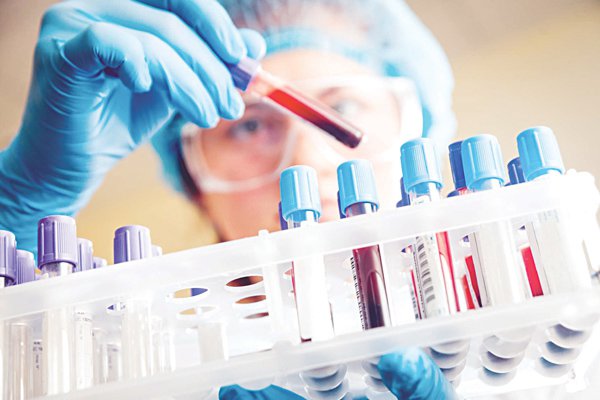What is Anti-Mullerian Hormone (AMH)?
The article is professionally consulted by Master, Doctor Thai Bang - Faculty and Master's School, Doctor Nguyen Van Thanh - Department of Obstetrics and Gynecology - Vinmec Nha Trang International Hospital
Due to the increasing attention of women's reproductive health needs, the prognostic examination of future pregnancy is receiving more attention, the phrase anti-mullerian (AMH) is thus more known. . So what is AMH and what role does it play in a woman's reproductive period, let's find out in the article below..
1. What is an AMH test?
AMH stands for Anti-Mullerian Hormone, which is the name of a hormone produced by the granulosa cells of the pre-ovulatory follicles and follicular follicles in the ovary starting at 36 weeks gestation. The follicular follicles continue to secrete AMH until the stage is about 4-6mm in size. The ovarian follicles then begin to become sensitive to FSH from about this stage onward, or possibly earlier (from 2mm or more in size).
AMH reflects both the number of developing follicles and the population of primordial follicles present in a woman's ovaries. Therefore, AMH is also considered an indicator of ovarian reserve, and can predict a woman's fertility now and in the future. The AMH index peaks at age 25 and declines over time.
AMH does not fluctuate during the menstrual cycle, so it is more accurate than the old standard of measuring FSH levels - which often fluctuates with the menstrual cycle and is affected by many other factors. Therefore, the AMH test is by far the most accurate test for evaluating ovarian reserve.

AMH là xét nghiệm chính xác nhất giúp đánh giá khả năng dự trữ buồng trứng
2. How much AMH is normal?
Although AMH levels do not change with the menstrual cycle, there will be a decrease with age or affected by medical factors, stress. In healthy women under 38 years of age, normal AMH levels range from 2.2 to 6.8 ng/ml.
A low AMH level (1.0-1.5 ng/ml) indicates reduced ovarian reserve, but there is still a chance of pregnancy. An extremely low AMH (less than 0.5ng/ml) indicates very little egg reserve and fertility is a concern.
In contrast, those with a high and too high AMH index (>10 ng/ml, common in women with PCOS), without modern interventions, the likelihood of having a baby is very high. short.
3. Factors affecting AMH
Age Ethnicity Smoking, drinking Obesity Polycystic ovaries Use of birth control pills Chemotherapy, radiation surgery One or both ovaries
4. Subjects to be tested for AMH

Phụ nữ cần xét nghiệm AMH khi bị vô sinh hiếm muộn
Women need AMH test when having disease:
Infertility and infertility Polycystic ovaries Premature ovarian failure Menstrual disorders, amenorrhea, amenorrhea and amenorrhea Effective monitoring of infertility treatment Ovarian cancer eggs Prognosis of menopause
5. Role of AMH in clinical tests
5.1 AMH monitors the aging of the ovaries
Ovarian aging is a phenomenon in which the number and quality of eggs in the ovaries decrease over time. Although the average age of menopause in women is around 50 years old, in some cases it will happen earlier, about 1 in 10 women will go through menopause before age 45 and 1 in 100 may go through menopause before 40. age. Repeated AMH testing over time can help assess the number of oocytes remaining in the ovary and the progression of ovarian aging.
5.2 AMH predicts future fertility
AMH declines over time at a different rate for each person. Therefore, testing for AMH and then repeated testing over time can help predict the remaining fertility and the rate at which the ovaries are aging. From there, it is possible to advise women on the right time to get pregnant naturally or to intervene with fertility treatment.
5.3. AMH predicts menopausal age
In cases of premature ovarian failure or early menopause, AMH decreases rapidly and is lost very soon. Therefore, the AMH test can help diagnose and predict the onset of menopause in women so that they can actively use hormone replacement, reduce the risk of osteoporosis and premenopausal diseases, and reduce the risk of osteoporosis. early menopause in women.

AMH tiên lượng tuổi mãn kinh
5.4. AMH predicts ovarian damage after surgery and after cancer treatment
Indications for surgery on the ovaries are increasing due to the widespread popularity of laparoscopic surgery in gynecology. At the same time, using electrocautery to stop bleeding and cutting and dissection procedures on the ovary have the risk of reducing the number of existing follicles in the ovary.
AMH can be used as an early, reliable and direct marker for ovarian tissue damage after surgery or cancer treatment. Although there is no method that can restore ovarian reserve if AMH is found to be greatly reduced after surgery. However, information on adverse ovarian reserve after surgery can help advise patients on appropriate treatment strategies to be able to conceive using modern and advanced assisted reproductive techniques.
AMH can be used as an early, reliable and direct marker for ovarian tissue damage after surgery or cancer treatment. Although there is no method that can restore ovarian reserve if AMH is found to be greatly reduced after surgery. However, information on adverse ovarian reserve after surgery can help advise patients on appropriate treatment strategies to be able to conceive using modern and advanced assisted reproductive techniques.
Để đặt lịch khám tại viện, Quý khách vui lòng bấm số HOTLINE hoặc đặt lịch trực tiếp TẠI ĐÂY. Tải và đặt lịch khám tự động trên ứng dụng MyVinmec để quản lý, theo dõi lịch và đặt hẹn mọi lúc mọi nơi ngay trên ứng dụng.
Bài viết này được viết cho người đọc tại Sài Gòn, Hà Nội, Hồ Chí Minh, Phú Quốc, Nha Trang, Hạ Long, Hải Phòng, Đà Nẵng.





